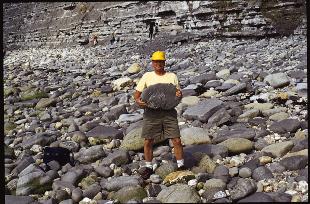 |
|||
|
|
|
|
|
 |
|||
|
|
|
|
|

Force Five at the Earth TheaterOpening November 24, 2000 You
donít want to be anywhere near an actual Force Five on the five-step scale
of measuring wind speeds.The scale
goes from "Weak" (Force 0ne--or 74 to 95 miles per hour) to "Catastrophic"
(Force Five--more than 156 miles per hour). Devastating Force Five winds
create storm surges of water 19-feet higher than normal sea level, and
will just blow you away--along with everything else around you.
Force Five at the Earth Theater of Carnegie Museum of Natural History is all about the power of nature's forces, such as Hurricanes, Tornadoes, Volcanic Eruptions, and Solar Storms.In fact those are the parts of the show, which comes at you in a 20/20 television show format--with experts telling you what you need to know about each of these phenomena. But it's also about the tools of earth scientists, and how modern science studies, measures and forecasts these events.If the forecasting skills of 1906 were what they are today, Galveston, Texas night have might have been prepared to survive the hurricane that wiped it out that year.In Force Five you find out how the global temperature changed after Mt. St. Helens erupted in 1980.You also find out why Solar Storms cause blackouts in Canada and alter the way space satellites work. Force Five is the third new show featured at the museum's Earth Theater.This state-of-the art digital theater features a 210-degree wrap-around horizontal screen called "SkyVision," and offers a new show on earth-related processes every six months.Carnegie Museum of Natural History co-produced Force Five with Houston Museum of Natural Science, which premiered the technology two years ago.These shows use readily available computers with specially designed software, and are likely to become the standard high-quality format that other earth science theaters will adopt. Each show runs about 24 minutes, and in Pittsburgh Force Five will be teamed with the Geography Show, especially designed for children, as a double feature on alternative show times.After Force Five premiers in Houston on Thanksgiving weekend, it opens here, where it can be seen regularly from 11:00 to 3:00pm weekdays,Saturdays 11:00 to 4:00, Sundays 1:30 - 4:30pm.There is a $2.00 per person admission charge. Where Did All the Scientists Go?In the year 2000
they went to places exotic and familiar
Each summer scientists
disappear from the offices and laboratories of the Carnegie Museum of Natural
History. Where do they go? That depends on where their research into natural
history takes them.
 Gotha,
Germany --- Vertebrate paleontology curator Dave Berman, scientific preparator
Amy Henrici, and Richard Kissel continued work in the Bromacker Quarry.
Bermanís fossil finds have helped to clarify when reptiles first became
able to live semi-independently of water, and provided undeniable biological
evidence that Europe and North America were connected during the late Paleozoic.
Tibet---
Chris Beard, associate curator of vertebrate paleontology, set out in search
of fossil mammals from the beginning of the Cenozoic Era.He
was accompanied by colleague Zhexi Luo.
Gansu
Province, China--Zhexi Luo, associate curator of vertebrate paleontology,
went into the Gobi desert to search for dinosaur fossils.
Kalmykia,
Russia --- In May, Powdermill Nature Reserve director Joseph Merritt conducted
field research with Russian scientists examining what role the social biology
of rodents plays in transmitting plague between species.
Costa
Rica and West Indies--- Curator of anthropology Dave Watters and research
associate Oscar Fonseca continued studying former museum curator
C. V. Hartmanís field work at the burial ground at Chinchilla almost 100
years ago. Watters located 45 additional images of Hartmanís
work, which provide information about the distribution of artifacts and
graves.Watters also visited the
islands of Antigua and Montserrat where he continues his long-standing
archaeological research.
Botai,
Kazakhstan --- Associate curator of anthropology Sandi Olsen continued
investigating whether the Eneolithic (3600-2300 B.C.) settlement at Botai
may be one of the earliest locations for horse domestication. With collection
manager Deborah Harding, Olsen also studied cloth, cord, basket, and comb
impressions in pottery from the site.
United
States --- Closer to home, invertebrate paleontology collection manager
Albert Kollar and research associate David Brezinski traveled to Alabama,
Georgia, Tennessee, Virginia, and West Virginia. Their research examines
how two-valved, shelled invertebrates called brachiopods adapted as the
reefs in which they lived changed during the Upper Paleozoic.
---Orr Goehring Managing Editor, Scientific Publications
Scenes of Western Pennsylvania: The Photography of Donald M Robinson October 25, 2000
to January 25, 2001
The world-famous Pittsburgh
photographer presents 67 stunning images of the pristine landscape of western
Pennsylvania.
|
|
|
|
|
|
|
All rights reserved. E-mail: carnegiemag@carnegiemuseums.org |
|||